Travel Guide, Ha Giang Loop
An In-Depth Guide for Traveling from Ha Giang to Cao Bang
Embark on a journey where every turn unveils a new horizon, and each mile tells a story steeped in cultural and natural beauty. This Ha Giang to Cao Bang stretch, bridging Ha Giang’s rugged terrain to Cao Bang’s serene landscapes, is a symphony of diverse cultures, historical echoes, and nature’s artwork at its finest. Crafted for the discerning traveler, this guide is a blend of practical advice and evocative narrative, aimed at immersing you in the very soul of Northeastern Vietnam.
When is the Best Time to Visit Ha Giang and Cao Bang?
Ha Giang and Cao Bang each have their unique beauty in different seasons. However, if you’re asking about the best time to visit for convenience and beautiful scenery, I would recommend Autumn and Spring. Unlike the cold winter or the harsh summer sun, these two periods offer pleasant weather in Ha Giang and Cao Bang, allowing you to travel comfortably and engage in various tourist activities without much weather-related hindrance. Spring, with its blooming flowers and fruit, and Autumn, with its ripe rice fields, offer breathtaking mountainous landscapes that will captivate any traveler, regardless of the season.
How Far is it from Ha Giang to Cao Bang?
The distance from Ha Giang to Cao Bang is about 250km following the QL34 route. The journey by bus takes approximately 7-8 hours. Cao Bang is famous for its majestic mountains and pristine nature, including Vietnam’s most beautiful Ban Gioc Waterfall and the world-renowned Nguom Ngao Cave. Cao Bang is also a land of revolutionary tradition, with famous historical sites like Pac Bo Cave and the Kim Dong Monument, where the precursor to the Vietnam People’s Army was established.

For those who love motorbiking, it’s also a viable option, though it takes more time and energy. The road from Ha Giang to Binh Nguyen is quite rough, so be careful on this route; however, the route from Binh Nguyen to Cao Bang is very beautiful. Be cautious when traveling by motorbike.
Both Cao Bang and Ha Giang are located in the Northeast mountainous region of Vietnam. Currently, few bus options are available, with only 30-seat buses being the norm. It might be a bit challenging, but traveling by bus in the highlands can be an interesting experience, offering unique perspectives on life and ethnic cultures along the way.
Suggested Itinerary for Ha Giang Cao Bang
DAY 1: HA GIANG CITY – QUAN BA – YEN MINH – LUNG CU – LO LO CHAI VILLAGE
From Hanoi to Ha Giang, the first stop in Ha Giang City is the milestone number 0. Then, you’ll head to Bac Sum Slope to reach Quan Ba Heaven Gate and the majestic Twin Mountains, 40km from the city.
In Yen Minh, stop for lunch at a local restaurant. Continue the journey to the famous slopes: Tham Ma and Chin Khoanh – marking the gateway to Dong Van highland.
In Dong Van, visit places like the Vuong Family Palace and Lung Cu Flag Tower, then head to Lo Lo Chai village for dinner and overnight stay.
DAY 2: MA PI LENG PASS – NHO QUE RIVER – CAO BANG
From Lo Lo Chai, travel to Ma Pi Leng Pass. Here, you can enjoy a boat ride on the Nho Que River before heading to Meo Vac for lunch and then on to Cao Bang.
Upon arrival in Cao Bang, stay overnight and dine at a homestay in Bao Lac town. Meanwhile, you can explore the Bao Lac market to learn more about the local ethnic culture.
DAY 3: BAO LAC – HA QUANG – LENIN STREAM – PAC BO CAVE
On day 3, visit Bao Lac and Ha Quang. Travel along the winding Me Pia pass (2.5km long) to the Xuân Trường valley for a rest.
Next, visit Lenin Stream and Pac Bo Cave in Ha Quang district, two famous historical sites associated with President Ho Chi Minh. End the day with dinner and rest at a homestay near these locations.
DAY 4: PHUC SEN FORGING VILLAGE – BAN VIET LAKE – PHAT TICH PAGODA
Next on the Ha Giang Cao Bang journey is Phuc Sen Forging Village. Here, you’ll learn about the culture and lifestyle in this traditional craft village.
After leaving the village, head to Ban Viet Lake for its picturesque natural scenery, perfect for photos. Finally, visit the serene and ancient Phat Tich Pagoda before resting at a homestay in Co Chuoi Ky stone village.
DAY 5: BAN GIOC WATERFALL – HANOI
After a night’s rest, visit Ban Gioc Waterfall – Vietnam’s most beautiful waterfall. Enjoy camping or boating here.
Have lunch in Cao Bang and then head back to Hanoi, concluding the 5-day, 4-night Ha Giang Cao Bang tour.
How to Travel from Cao Bang to Other Destinations
Ban Gioc Waterfall
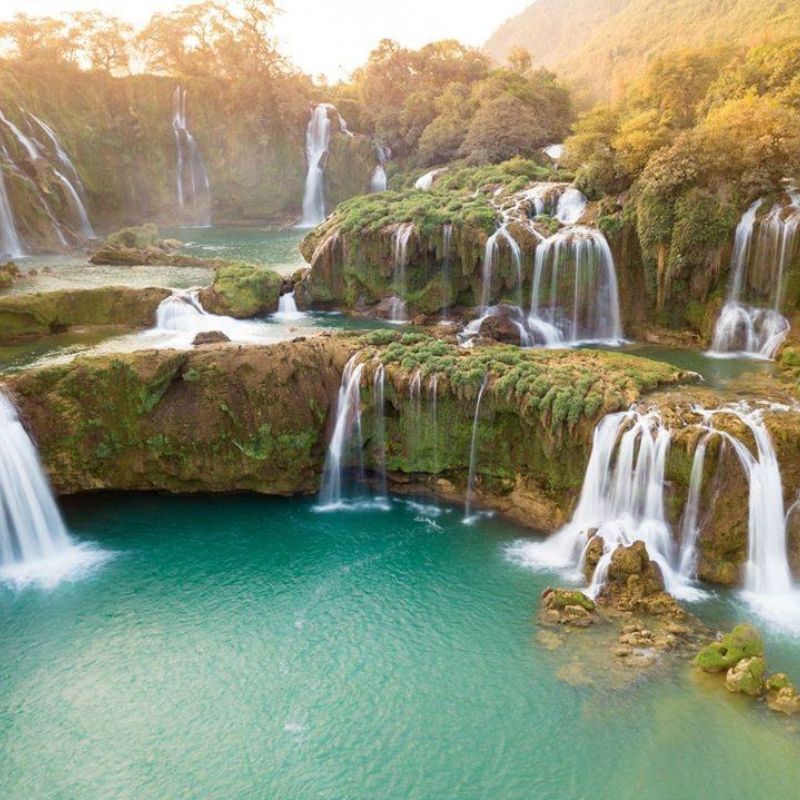
From Cao Bang city center, travel 89km through Ma Phuc and Khau Lieu passes, passing villages and along the Quay Son River to reach Ban Gioc Waterfall in Dam Thuy commune, Trung Khanh district, Cao Bang province.
Ban Gioc Waterfall, 35m high and 300m wide, is a multi-tiered waterfall with various cascades. The large water volumes create a misty scene as they flow over limestone steps. The sound of the waterfall can be heard from afar, echoing across the land.
The waterfall has inspired many artists to create exceptional paintings and photographs. Its simple and wild beauty is overwhelmingly captivating. Whether raging or calm, the waterfall never ceases to flow.
You can also experience bamboo rafting or kayaking on the Quay Son River, guaranteeing unforgettable moments.
Thang Hen Lake
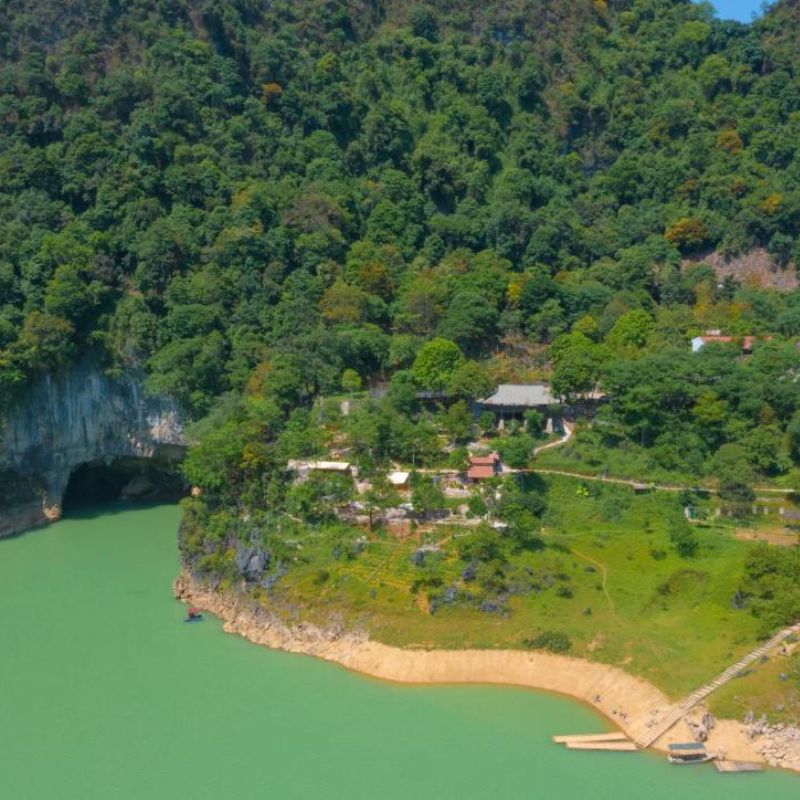
Known also as Thang Hen Lake, this large freshwater lake in Cao Bang province consists of 36 different-sized lakes, located in Quoc Toan commune, Tra Linh district, about 30km from Cao Bang city center.
The lake’s surface resembles a jade mirror nestled among green forest-covered mountains, offering picturesque and poetic scenery. From a distance, the lake’s shape resembles a giant “bee tail,” fitting its Tay ethnic name meaning.
The main lake is diamond-shaped, with the widest part being 500m and the longest 2,000m, and some areas are hundreds of meters deep. Floating on the lake, visitors can travel from one lake to another, enjoying the stunning scenery of green mountains and clear waters.
Ma Phuc Pass
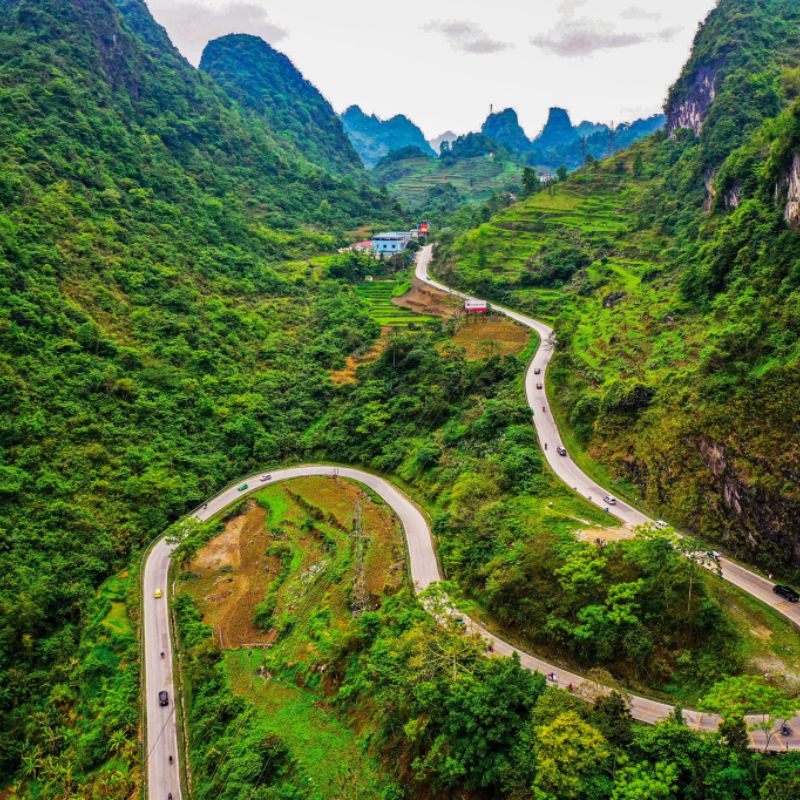
Located in Quoc Toan commune, Tra Linh district, about 20km from Cao Bang city, Ma Phuc Pass is approximately 3.5km long and 700m above sea level. It is known for its challenging route, making it popular among adventurous travelers.
Ma Phuc Pass, also known as the “seven-tier pass”, requires navigating through seven steep bends and curves. To conquer this road, one needs to be a skilled driver or travel with experienced companions.
Nguom Ngao Cave
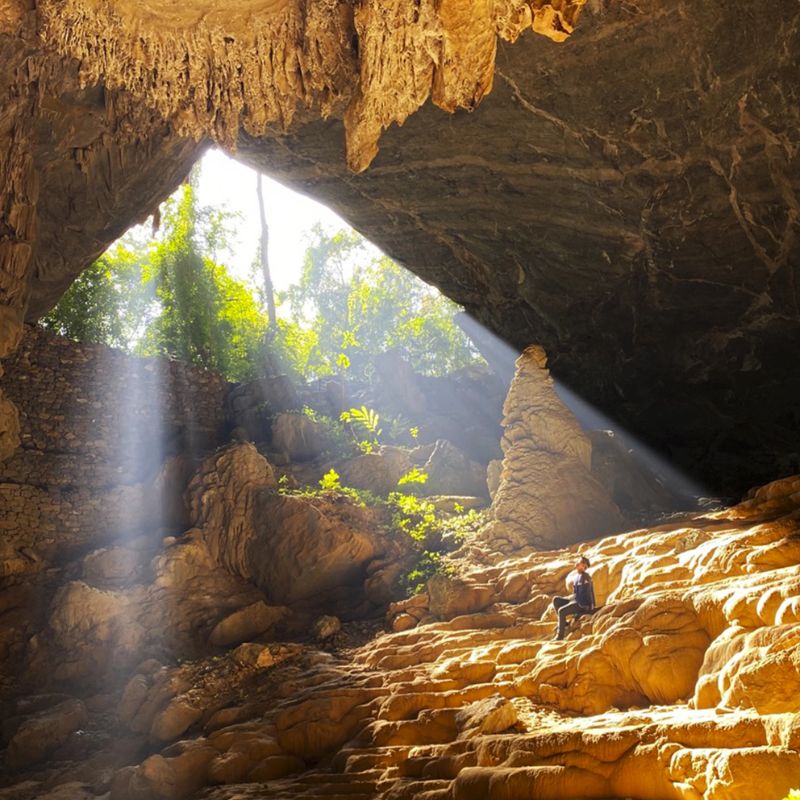
Nguom Ngao Cave is in Dam Thuy commune, Trung Khanh district, Cao Bang province. From Cao Bang city, cross Ma Phuc and Khau Lieu passes to Trung Khanh town. After traveling another 30km, you’ll reach Ban Gioc Waterfall, with Nguom Ngao Cave just 3km away. Both attractions can be visited on the same route.
The cave is one of Vietnam’s most beautiful, with a natural stalactite and stalagmite system forming vivid and fascinating shapes like coral trees, solitary stone columns, gold and silver waterfalls, inverted lotus pedestals, and more. These formations are untouched by humans, adding to the cave’s allure.
Lenin Stream
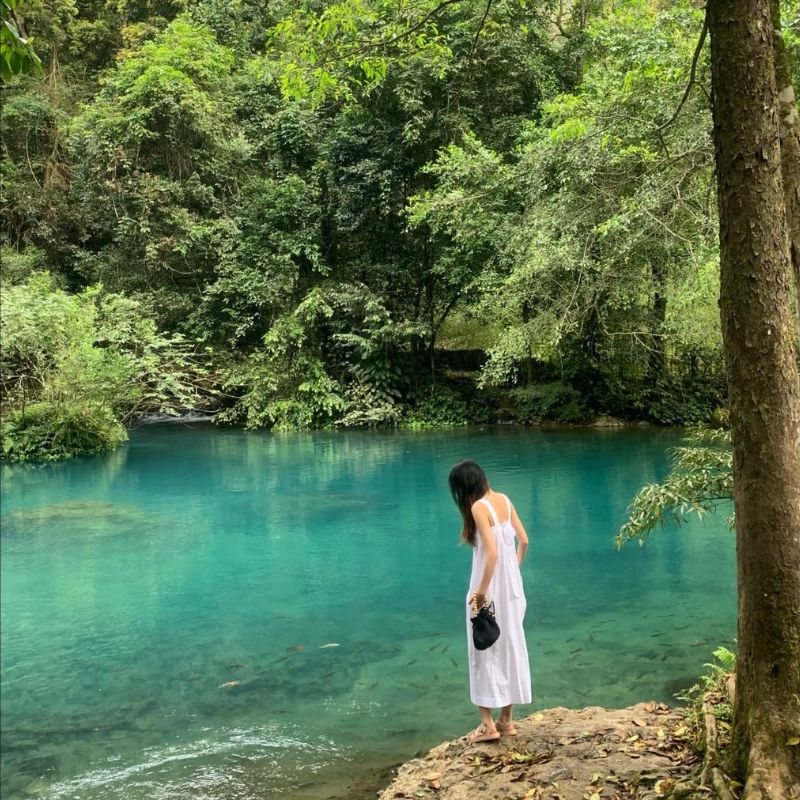
Lenin Stream, part of the Pac Bo historical site in Cao Bang, is renowned for its crystal-clear waters that reveal the streambed like a mirror reflecting the sky and landscape, creating breathtaking scenery. This destination is beloved for its quiet, romantic, and poetic atmosphere. No words can fully describe the beauty and purity of Lenin Stream.
Over the years, the stream has maintained its beauty, increasingly attracting visitors with its calm and charming water. Here, visitors can feel connected to the place where President Ho Chi Minh once lived, as if sensing his presence and seeing the landscapes he was once close to during the resistance period.
Tips Traveling from Ha Giang to Cao Bang
Traveling from Ha Giang to Cao Bang offers a spectacular opportunity to explore some of the most stunning landscapes in Vietnam. Here are some tips to make your journey smooth and enjoyable:
- Choose the Right Transport: The most common way to travel between Ha Giang and Cao Bang is by bus, motorbike, or private car. Buses are economical but can be time-consuming and less flexible. Motorbiking offers a more adventurous experience but requires good riding skills, especially on mountainous roads. Private cars or taxis provide comfort and flexibility but are more expensive.
- Plan Your Route: The distance is approximately 250km via National Highway QL34. Be aware that mountain roads can be challenging, with sharp turns and steep sections. Make sure to study the route beforehand and plan for rest stops.
- Check the Weather: Weather in the mountainous regions can be unpredictable. Check the forecast before you set off and be prepared for sudden changes in weather, especially if you’re traveling by motorbike.
- Pack Appropriately: Bring layers of clothing, as temperatures can vary, especially in the evenings and early mornings. Include rain gear, sun protection, and essential travel items.
- Stay Safe: If you’re driving or riding, ensure your vehicle is in good condition. Always wear a helmet when on a motorbike. Drive cautiously, as roads can be slippery, especially after rain, and visibility can be low in foggy conditions.
Conclusion
As our guide draws to a close, it’s evident that the journey from Ha Giang to Cao Bang is more than a mere traversal through Vietnam’s northeastern corridor; it’s a passage through a realm where time-honored traditions meet nature’s majestic creations. We’ve journeyed together from the craggy peaks of Ha Giang, through the lush valleys and ethnic tapestries of the region, to the cascading splendor of Cao Bang’s waterfalls. We hope that these pages have not only served as a guide but also as an inspiration, kindling a deeper appreciation for the rich tapestry of landscapes and cultures that define this extraordinary region.
What are the road conditions like between Ha Giang and Cao Bang?
The road conditions between Ha Giang and Cao Bang vary, reflecting the mountainous and rugged terrain of Northeastern Vietnam. While several stretches of the route are well-paved and offer smooth driving, travelers should be prepared for winding and narrow sections, particularly as they navigate the highland areas. These roads can be challenging, especially in adverse weather conditions like heavy rain or fog, which can reduce visibility and make the surfaces slippery. Additionally, some parts of the journey may involve steep ascents and descents, requiring careful navigation. For motorbikers, it’s crucial to be cautious, as the terrain demands good riding skills.
What is the best mode of transportation for this trip?
The best mode of transportation for the trip from Ha Giang to Cao Bang largely depends on personal preferences and experience. For those seeking comfort and convenience, buses are a practical choice, offering a relatively economical and relaxed way to travel, albeit with less flexibility in terms of stops and exploration. Adventurous travelers often prefer motorbikes, which provide a more intimate experience of the scenic route, allowing for spontaneous detours and closer interaction with the landscape.
Motorbiking requires good riding skills and preparation for the mountainous terrain but offers a uniquely thrilling and immersive journey. Alternatively, renting a private car or hiring a taxi can offer comfort and flexibility, though at a higher cost. This option is ideal for those traveling in groups or seeking a more leisurely pace without the challenges of driving on mountainous roads.
Are there any must-see attractions along the way?
The journey from Ha Giang to Cao Bang is dotted with numerous must-see attractions that showcase the region’s natural beauty and cultural richness. One of the most awe-inspiring sights is the Ma Pi Leng Pass, known for its breathtaking views of steep hills and deep valleys. The Nho Que River, with its striking turquoise waters, offers a serene and picturesque landscape, ideal for photography enthusiasts. As you approach Cao Bang, the Ban Gioc Waterfall, one of the largest and most impressive waterfalls in Vietnam, is a highlight not to be missed. This natural wonder, located on the border with China, is a spectacular sight with its multi-tiered cascades.

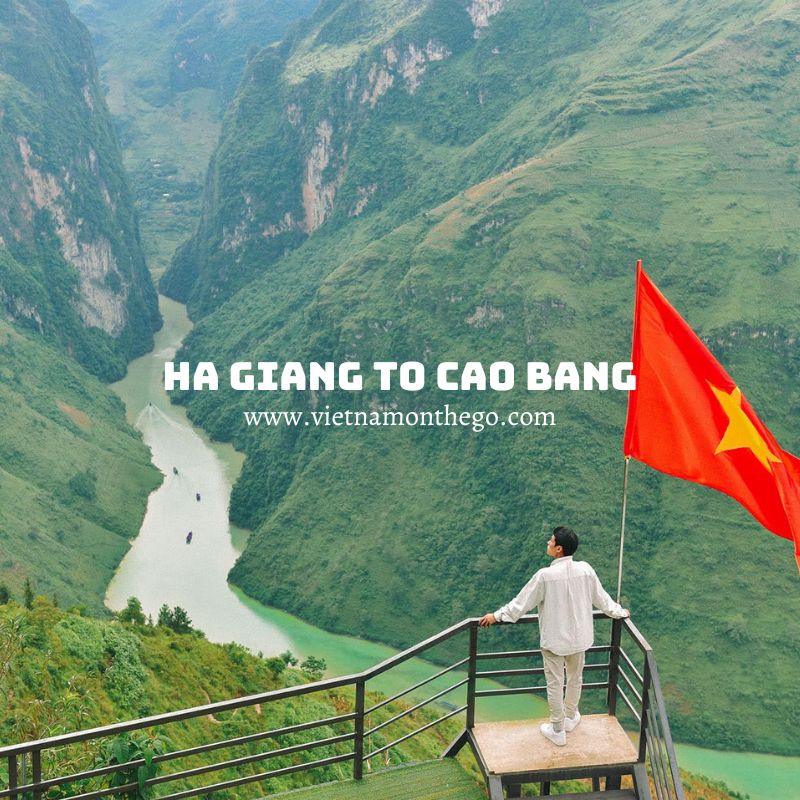
![[3 DAYS 4 NIGHTS] Ha Giang Loop Motorbike Tour from Hanoi](https://vietnamonthego.com/wp-content/uploads/2024/03/ha-giang-loop-tour-6-300x300.jpg)
![[4 DAYS 5 NIGHTS] Ha Giang Loop Motorbike Tour from Hanoi](https://vietnamonthego.com/wp-content/uploads/2024/03/ha-giang-loop-tour-300x300.jpg)